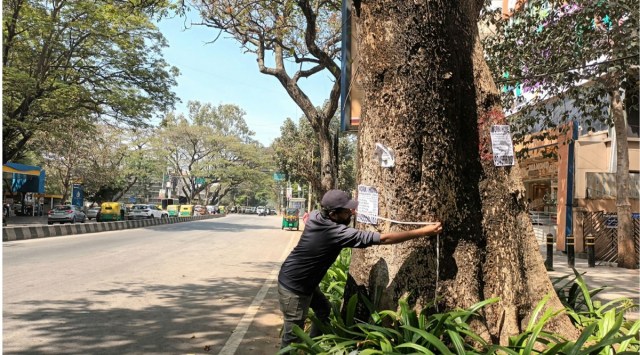Stay updated with the latest - Click here to follow us on Instagram
Tree felling due to Sankey flyover project in Bengaluru will impact biodiversity: Report
The report prepared by Harini Nagendra and Seema Mundoli from Azim Premji University and Vijay Nishanth, founder of NGO Vruksha Foundation, was released on Thursday.
 Measuring the girth of a tree at the site of the project. (Arranged picture/Vijay Nishanth)
Measuring the girth of a tree at the site of the project. (Arranged picture/Vijay Nishanth) A report titled ‘Environmental Impacts of proposed Flyover on Sankey Road’ reveals that 55 trees of 23 species will be cut on the 600-metre stretch where the proposed flyover will be constructed. In addition to this, 27 trees of 11 species will be impacted due to the flyover project.
The report prepared by Harini Nagendra and Seema Mundoli from Azim Premji University and Vijay Nishanth, founder of NGO Vruksha Foundation, was released on Thursday.
The report presents findings of a rapid environmental impact assessment conducted to determine the number of trees that will be cut or impacted and other ecosystems affected as a result of the proposed flyover.
“The tree felling will have multiple environmental impacts that are irreversible. These include decreasing green cover that inhibits carbon sequestration, rising air pollution, adverse impacts on urban biodiversity and compromising the lake ecosystem of Sankey Tank,” the report said.
The project comprises building a flyover, as well as ramps on Sankey Road between Malleshwaram 18th Cross and Cauvery Junction on Bellary Road. According to the Detailed Project Report (DPR), the length of the flyover will be 600 metre and there will be 470 metre length ramps.
The researchers also said heritage trees will be impacted due to the project.
“A tree can be classified as a ‘heritage tree’ if it meets a range of criteria — it is of a particular size, shape, form, age, or has a notable physical feature, or is of cultural value, or associated with an important place or event. The largest tree on Sankey Road we measured was an Indian rubber fig with a girth of 1100 cm and height of 12 m. While this tree is not marked to be cut for the project, there could be adverse impacts because of the construction of the proposed flyover. Heritage trees across cities in India are threatened by development projects. Recognising their importance, the Uttar Pradesh and Chandigarh governments have issued orders to protect heritage trees. For its heritage and ecological value, as well as the value it holds for the local citizens, the India rubber fig on Sankey Road qualifies as a heritage tree requiring protection, along with other trees on the road,” the researchers said in the report.
The report further highlighted that the destruction of the trees and the canopy on the road where the flyover is proposed will have severe consequences on the flourishing biodiversity around the area.
“The greenery surrounding Sankey Tank provides roosting and nesting spaces for birds, while the water itself is a source of food and habitat for waterbirds. The tank ecosystem also harbours the harder to spot species of amphibians and reptiles. The tank is also a habitat for insects—important for their role as pollinators. The construction of the flyover, the noise, dust and light, would undoubtedly disturb the biodiversity in the area. But the long-term impacts of the flyover and the loss of tree cover would result in an irreversible loss of biodiversity. The greenery surrounding Sankey Tank provides roosting and nesting spaces for birds, while the water itself is a source of food and habitat for waterbirds. The tank ecosystem also harbours the harder to spot species of amphibians and reptiles. The tank is also a habitat for insects—important for their role as pollinators. The construction of the flyover, the noise, dust and light, would undoubtedly disturb the biodiversity in the area. But the long-term impacts of the flyover and the loss of tree cover would result in an irreversible loss of biodiversity,” it said.







